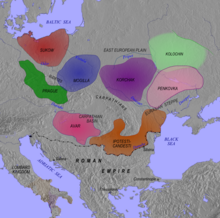
The Sukow or Sukow-Dziedzice group (German: Sukow-Dziedzice-Gruppe) or Sukow-Dziedzice culture (Polish: Kultura Sukow-Dziedzice, Russian: Суковско-дзедзицкая культура), also known as Szeligi culture, was an archaeological culture attributed to the Early Slavs. Areal of sites lays between Elbe and Vistula rivers in Northeast Germany and North West Poland. The earliest sites usually date to the second half of 7th and mid-8th centuries.[1][2]
There exist different views on its origin. It has features of both Przeworsk culture and Prague-Korchak culture. In comparison to Carpathian Slavic-speaking population of Korchak-Mogilany-type some consider Sukow-Dziedzice's had different population, maybe indigenous to Poland or arrived from within Poland and Belarus or a mixture of Korchak Slavs and indigenous post-Przeworsk population.[3] Slavic archaeologists including M. Kazanski identified the 6th-century Prague-Korchak culture and later Sukow-Dziedzice group as Sclaveni archaeological cultures, and the Penkovka culture (Prague-Penkovka) with Antes.[4][5]
- ^ Joachim Henning: Mecklenburg-Vorpommern und die Dendrochronologie zu slawischen Besiedlungsgeschichte Ostmitteleuropas - "Verwicklungen" und "Verwirrungen". Nitra 2004, S. 129–135, hier S. 133.
- ^ Lozny, 2013, pp. 71–78
- ^ Heather, 2009, pp. 412–414, 419, 426, 430–434, 449
- ^ James 2014, p. 96.
- ^ Kazanski 2020, pp. 3–4.